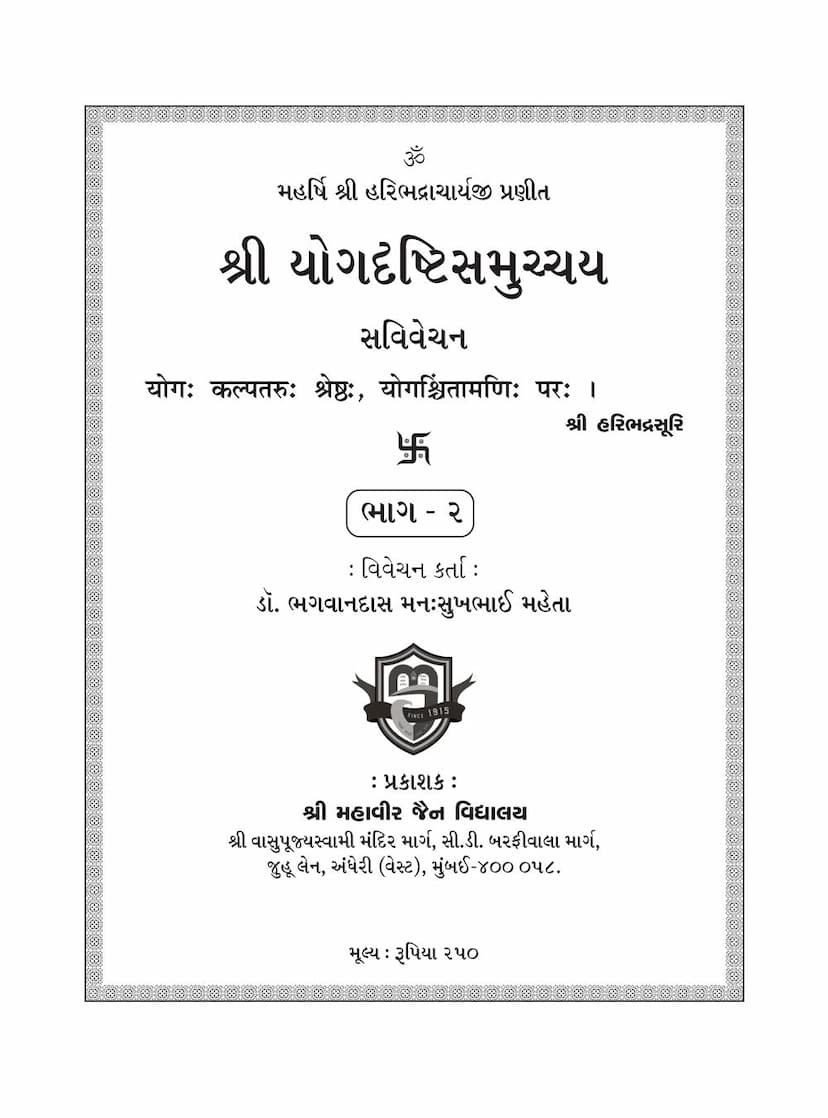Yogdrahti Samuchchaya Part 02
Added to library: September 2, 2025

Summary
The book "Yogadrusti Samuchchaya Part 02" by Bhagwandas Mansukhbhai Mehta, published by Shri Mahavir Jain Vidyalaya, is a detailed commentary and exploration of Jain philosophical and yogic concepts, primarily focusing on the spiritual journey and the attainment of liberation. The book is an extensive commentary on the original text "Yogadrushtisamuchchaya" by Acharya Haribhadrasuri.
Here's a breakdown of the key aspects of the text based on the provided summary:
1. Core Subject Matter: The book delves into the "Yogadrushtisamuchchaya," a significant Jain text that outlines various stages and perspectives (Drishtis) of yogic practice and spiritual development. The commentary aims to elucidate these profound concepts in a comprehensive and accessible manner.
2. Author and Publisher:
- Author of Commentary: Dr. Bhagwandas Mansukhbhai Mehta.
- Author of Original Text: Maharshi Shri Haribhadrasuriji.
- Publisher: Shri Mahavir Jain Vidyalaya, Mumbai.
3. Purpose and Philosophy: The primary goal of the book, as indicated in the introductory pages, is to guide individuals on the path of spiritual development towards achieving "Moksha" (liberation), which is considered the ultimate goal of a soul according to Jain teachings. The text emphasizes the importance of "Yoga" and "Adhyatma" (spirituality) for the soul's gradual progress. It highlights that knowledge acquisition is achieved through the study of rare texts and yogic practices, with Acharya Haribhadrasuri's "Yogadrushtisamuchchaya" being considered a paramount work in this regard.
4. Structure and Content: The provided pages offer a glimpse into the detailed structure and content of the book.
- Commentary: Dr. Bhagwandas Mansukhbhai Mehta provides a detailed commentary ("Vivechan").
- Key Concepts Covered: The index and content pages reveal discussions on topics such as:
- Tarkik Reasoning vs. True Knowledge: The text addresses the limitations of dry logic ("Shushk Tark") in understanding transcendental truths and emphasizes the role of scripture ("Aagam") and intuition ("Anuman") aided by yoga.
- The Nature of the Soul and Liberation: It discusses the soul's journey, the path to liberation, and the attainment of higher spiritual states.
- Different Perspectives on Reality: The commentary likely explores various philosophical viewpoints and how they relate to the ultimate reality.
- The Role of the Guru: The importance of a spiritual teacher is highlighted.
- Ethical and Yogic Practices: The text details the principles of non-violence (Ahimsa) and other yogic disciplines.
- Stages of Spiritual Progress: The concept of different "Drishtis" (perspectives or stages of spiritual vision) is central, with the text detailing stages like Diptadrishti, Sthiradrishti, Kantadrishti, Prabhadrushti, and the ultimate Para-drishti. These stages represent the progressive purification and elevation of the soul's consciousness.
- Critique of False Reasoning: The text strongly criticizes blind adherence to logic and superficial arguments ("Kutark") that deviate from genuine spiritual understanding. It emphasizes that true knowledge comes from scriptural authority and personal spiritual realization through yoga.
- The Importance of the Gist: The commentary focuses on extracting the essence of these teachings, highlighting that true liberation is attained through the path of yoga and spiritual practice.
5. Publisher's Information and History:
- Establishment of Mahavir Jain Vidyalaya: The book also provides historical context about the founding of Shri Mahavir Jain Vidyalaya by Acharya Vijay Vallabhsurishwarji Maharaj over 100 years ago, driven by the need for educational facilities for Jain students and the promotion of Jain literature.
- Various Branches and Initiatives: It lists the various branches and hostels established by the Vidyalaya across different cities and highlights their commitment to holistic development, including religious education, vocational training, and financial aid for students.
- Emphasis on Jain Principles: The Vidyalaya's operations adhere to core Jain principles like the prohibition of nighttime meals, abstinence from forbidden foods (Abhakshya), and the integration of religious studies with academic pursuits.
- Re-publication Details: The third edition of this particular publication marks a significant effort by the Vidyalaya to re-publish Dr. Bhagwandas Mehta's valuable commentary, supported by generous contributions and permissions from various individuals and organizations.
6. Linguistic and Scholarly Nature: The text is written in Gujarati, and the commentary ("Vivechan") is scholarly, engaging in deep philosophical and textual analysis. The presence of verses, their interpretation, and the exploration of various philosophical arguments indicate a rigorous academic and spiritual treatment of the subject.
In essence, "Yogadrushti Samuchchaya Part 02" with its detailed commentary by Dr. Bhagwandas Mansukhbhai Mehta is a profound exploration of Jain yogic philosophy, aimed at guiding the seeker towards ultimate spiritual realization. It provides a historical context of the publisher's dedication to Jain education and literature, while the commentary itself delves into the intricacies of yogic stages and the critique of superficial spiritual understanding.